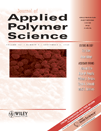Effect of interfacial attraction on intercalation in polymer/clay nanocomposites
Abstract
In order to examine the adhesive behavior of a polar polymer between hydrophilic clay layers, the so-called glue effect, a clay intercalation by an ethylene–vinyl alcohol (EVOH) copolymer, which was capable of strong hydrogen bonding with the silicate surface of clay, was prepared by the melt intercalation technique and compared with a clay nanocomposite containing styrene–acrylonitrile (SAN) copolymer of less polar interaction energy in terms of the morphology and mechanical properties. Although initial penetration of the guest polymer into the gallery of the host clay occurred more rapidly for EVOH because of its strong hydrophilic nature, the dissociation of clay nanoplatelets was better developed for SAN with less polar interaction with clay, well evidencing the fact that the glue effect effectively affects the intercalation behavior of polymer/clay nanocomposites. However, the mechanical properties of the EVOH/clay nanocomposite were superior to those of SAN/clay nanocomposites. Although dissociation of respective silicate layers was poor for EVOH/clay nanocomposites, strong attractive energy stabilizes the interface between inorganic nanoparticles and the polymer matrix much more effectively, resulting in higher mechanical properties. © 2006 Wiley Periodicals, Inc. J Appl Polym Sci 101: 2749–2753, 2006




